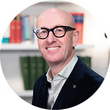- OT
- Life in practice
- Practitioner stories
- Outside of the box
Outside of the box
OT speaks to Dr Paul Gifford about his varied day-to-day life in practice, and what the future might hold for the profession

12 August 2016
What is a typical working day like for you?
I am really fortunate that my work is varied. I typically spend two days per week at a local contact lens lab, which is mostly spent working with its team to develop new lens designs, but at short notice my job can require solving old DOS-based software problems on one of the lathes, with the nearest support from the lathe manufacturer being in the US. The rest of the time I work mainly from home either catching up with the research groups I am involved with around the world, writing journal articles, or learning something new.
Which aspect of your current role inspires you the most?
Freedom to think outside the box. I spend part of my time consulting to the contact lens industry, helping it to develop new contact lens designs. Providing this service in a consulting role has given me the scope to avoid being restricted by existing ideologies and dogmas. In our independent optometry practice I get this same freedom working with my wife Kate to develop new approaches to keep ahead of the field.
Where do you see the direction of optometry heading in the next five years?
This is really interesting to consider, more so because this will largely depend on how optometry reacts to the changes in technology that we are going to see in the next five years. Profit erosion from selling glasses and contact lenses is an inevitability as we see the younger, more internet savvy generations form a greater proportion of the workforce. Meanwhile the scope of diagnostic equipment is going to increase exponentially. The only way to balance this disparity is to charge appropriately for medical services, which is something that we are historically not good at; in fact, I would go as far as saying that, as a profession, we are on the whole embarrassed and apologetic to patients when it comes to charging for the services we provide.
"We should not forget that our primary role is refraction...it’s not until you try to automate it, as some online services are currently trying, that you realise how difficult refraction actually is"
As a personal plea, I would dearly love to see optometry actively managing the recent increase in the prevalence of myopia and the significant health problem that this is starting to become. Myopia is our bread and butter, and we should all be involved in managing this, using vision correction modalities that have been shown to at least slow progression of myopia. Sadly, this doesn’t seem to be the case. The good news is that current evidence of high conference attendance on myopia topics suggests many are interested, and hopefully the next five years will see more of these practitioners taking a more active role.
What do you regard as being the most influential development to impact upon the clinical role of practitioners in recent years?
High resolution ocular imaging, which in a short time has dramatically revolutionised ocular disease diagnosis and management. Through routine use of optical coherence tomography (OCT), we are detecting early-stage disease that previously would not have been seen through light-based retinal imaging, even to the most trained eye. And this is just the start, with machine-based learning and rapidly evolving cloud-based technologies, we are going to see dramatic differences to the way we diagnose and manage ocular disease in the very near future.
What and who has been most influential in steering your career path to date?
Constant curiosity and always looking for the next mountain to climb. I have been fortunate to work with and alongside many influential individuals, but it is my first optometrist employer that, looking back, made the most difference. I left school at 16 with four O Levels and took on a job at a small independent practice in response to an advertisement at the local careers office. On starting, I asked what it takes to be an optometrist – this was the first time I had ever met one. He told me the required A Levels, followed by the offhand comment that I couldn’t do it! This wasn’t said with any malice; more an accurate assessment of my educational achievements to date, but it lit a fuse. It took me 10 years, but I did it, and ultimately went on to earn a PhD. I occasionally look back and wonder where I would have ended up without the unintended drive that this optometrist gave me.
If you had the power to change any aspect of the current remit of optometrists what would it be?
We should not forget that our primary role is refraction. During my career I have seen massive change in our profession, with ever-increasing scope of practice, in some cases driven by what seems to be a desire to distance us from the ease and consequent boredom of refraction. Yet, it’s not until you try to automate it, as some online services are currently trying, that you realise how difficult refraction actually is. Throw enough automated intraocular pressure measurements and retinal images at a computer and it will learn the patterns for glaucoma to give a more accurate diagnosis than a human. It will take development of true artificial intelligence to deal with the nuances of individual variation that we automatically compensate for when providing an accurate refraction. Refraction is a vital and difficult-to-automate cornerstone. We should never lose sight of this as we look for ways to increase the scope of optometry, as there are many who would love to see refraction deregulated, or included in their own remit of practice.


Comments (0)
You must be logged in to join the discussion. Log in